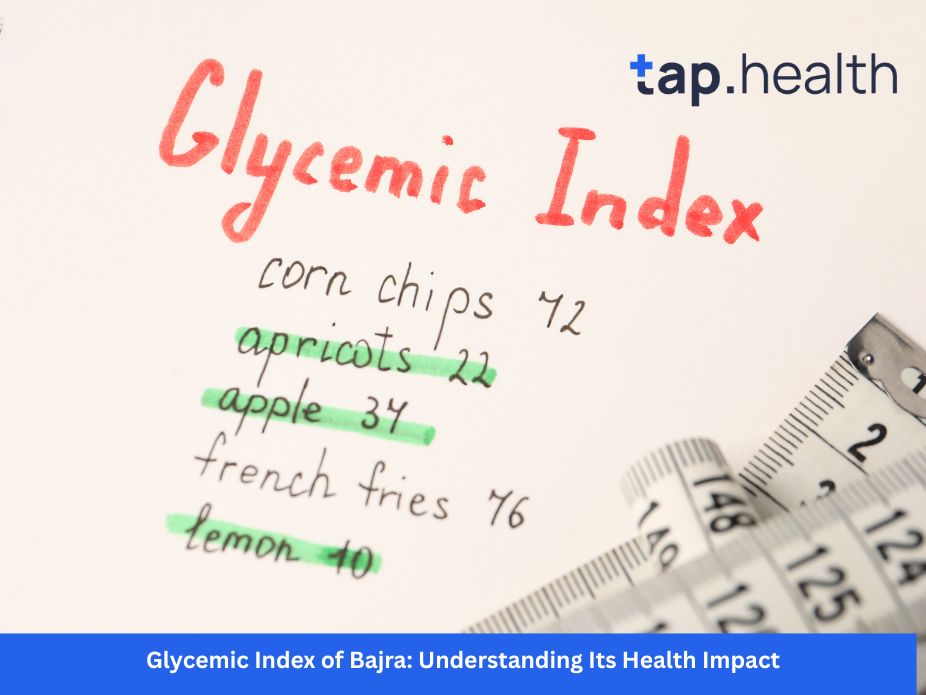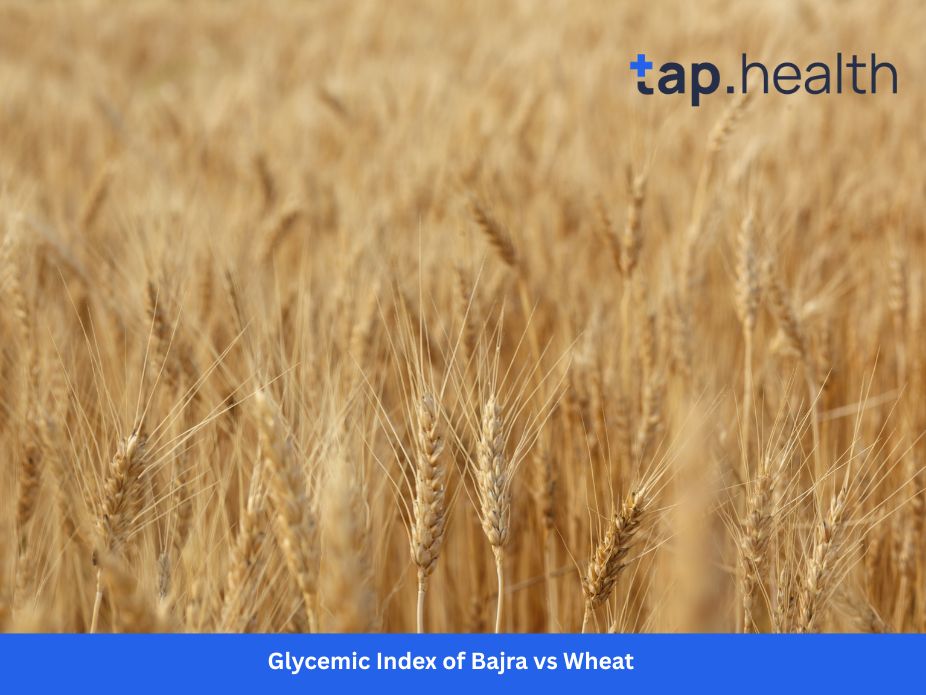Bajra, or pearl millet, is a popular grain in many parts of India, especially in rural and semi-urban areas. It is known for its impressive nutritional profile, being rich in fiber, protein, and essential minerals. But one of the most crucial factors that determine the health benefits of a food item is its glycemic index (GI). In this article, we will explore the glycemic index of bajra, its effect on blood sugar levels, and why it is considered a diabetic-friendly food. We will also cover the benefits, myths, and frequently asked questions related to bajra’s glycemic index, giving you a comprehensive understanding of this powerhouse grain.
What is the Glycemic Index?
The glycemic index (GI) is a numerical scale that ranks foods based on how quickly they raise blood glucose (sugar) levels after consumption. Foods with a high GI cause a rapid spike in blood sugar, while those with a low GI release glucose slowly, providing a steady and sustained energy supply.
- Low GI foods: GI value of 55 or less
- Medium GI foods: GI value of 56 to 69
- High GI foods: GI value of 70 or more
Foods with a low GI are preferred by individuals with diabetes, as they help maintain better blood sugar control. Now, let’s take a closer look at the glycemic index of bajra.
Glycemic Index of Bajra: What Does It Mean?
The glycemic index of bajra falls between 50 and 55, which places it in the low GI category. This means that bajra has a slower and more gradual effect on blood sugar levels, making it a suitable option for people with diabetes or those looking to manage their weight. By consuming bajra, you are providing your body with a steady supply of energy without causing sharp spikes in blood sugar.
Why Bajra’s Glycemic Index Matters
When it comes to managing diabetes or maintaining a healthy lifestyle, the GI of food plays a key role. Foods with a low glycemic index like bajra are beneficial for:
- Stabilising blood sugar levels: Bajra’s low GI ensures that glucose is released gradually into the bloodstream, preventing sudden spikes in blood sugar.
- Supporting weight management: Low GI foods help control appetite, making you feel full for longer, thus reducing the chances of overeating.
- Reducing the risk of Type 2 diabetes: By consuming foods like bajra, which help maintain healthy blood sugar levels, the risk of developing Type 2 diabetes can be reduced.
Nutritional Value of Bajra
Bajra is a powerhouse of nutrition. Its low glycemic index is just one of the reasons it is widely regarded as a health food. Here’s a breakdown of its key nutrients per 100g:
- Calories: 378 kcal
- Protein: 11g
- Carbohydrates: 73g
- Fiber: 8g
- Fat: 4g
- Iron: 8.5 mg
- Magnesium: 110 mg
- Calcium: 42 mg
Apart from its low glycemic index, bajra is also an excellent source of dietary fiber, which plays a crucial role in digestion and maintaining a healthy gut.
Health Benefits of Bajra
Now that we know the glycemic index of bajra, let’s dive into its many health benefits.
1. Diabetes Management
As mentioned, bajra’s low glycemic index makes it an excellent choice for people with diabetes. The slow release of glucose helps maintain balanced blood sugar levels, reducing the risk of complications associated with high blood sugar, such as nerve damage, kidney problems, and cardiovascular diseases.
2. Weight Loss Aid
The high fiber content in bajra ensures that you feel fuller for longer. This helps in reducing unnecessary snacking between meals, which can contribute to weight gain. Bajra’s slow digestion also helps keep you satisfied and prevents sudden hunger pangs.
3. Rich in Antioxidants
Bajra contains a variety of antioxidants, including phenolic acids and flavonoids, which help combat oxidative stress in the body. These antioxidants play a key role in fighting inflammation and protecting against chronic diseases.
4. Gut Health
The high fiber content in bajra also promotes gut health by acting as a prebiotic. Prebiotics are non-digestible fibers that support the growth of healthy gut bacteria, which are vital for overall digestive health and immune system function.
5. Heart Health
Bajra is rich in magnesium, which is essential for heart health. Magnesium helps in regulating blood pressure and maintaining a healthy heart. Bajra also contains healthy fats, which support cardiovascular health.
Bajra vs. Other Grains: A Comparison
It is essential to compare bajra’s glycemic index and health benefits with other commonly consumed grains.
| Grain | Glycemic Index (GI) | Calories (per 100g) | Carbs (per 100g) | Protein (per 100g) | Fiber (per 100g) |
|---|---|---|---|---|---|
| Bajra (Pearl Millet) | 50-55 | 378 kcal | 73g | 11g | 8g |
| Rice (White) | 70-90 | 130 kcal | 28g | 2g | 0.4g |
| Wheat (Whole) | 50-55 | 340 kcal | 71g | 13g | 12g |
| Oats | 55-58 | 389 kcal | 66g | 16g | 10g |
| Quinoa | 53 | 368 kcal | 64g | 14g | 7g |
As seen from the table, bajra has a similar glycemic index to whole wheat and oats but is superior to white rice, which has a higher GI. Bajra stands out as an excellent choice for diabetics and those looking to maintain a healthy diet.
How to Include Bajra in Your Diet
Bajra is a versatile grain that can be included in various dishes, from traditional to contemporary recipes. Here are a few ideas on how to incorporate bajra into your daily meals:
- Bajra Roti: A traditional Indian flatbread made from bajra flour, commonly consumed with vegetables, lentils, or yogurt.
- Bajra Porridge: A nutritious breakfast option, especially when combined with fruits, nuts, and seeds.
- Bajra Khichdi: A wholesome, comforting dish made with bajra, lentils, and spices.
- Bajra Salad: You can cook bajra and toss it with veggies, herbs, and a light dressing for a refreshing salad.
- Bajra Upma: A variation of the popular South Indian breakfast, where bajra is used instead of semolina.
Myths vs. Facts about Bajra
Myth 1: Bajra is only for people with diabetes.
Fact: While bajra is an excellent choice for diabetics, it is beneficial for everyone due to its nutritional value. It supports heart health, aids digestion, and provides sustained energy.
Myth 2: Bajra is difficult to cook.
Fact: Bajra is easy to cook and can be prepared in many ways, just like other grains. It can be boiled, roasted, or ground into flour to make various dishes.
Myth 3: Bajra is not suitable for people with gluten intolerance.
Fact: Bajra is naturally gluten-free, making it an excellent grain choice for those with gluten sensitivities or celiac disease.
Key Takeaways
- Bajra has a low glycemic index (50-55), making it a great food choice for stabilising blood sugar levels.
- It is packed with fiber, protein, and essential minerals like iron and magnesium.
- Bajra promotes gut health, heart health, and weight loss.
- It can be easily incorporated into your diet in various forms like roti, porridge, and khichdi.
- Bajra is gluten-free, making it a suitable option for those with gluten intolerance.
Frequently Asked Questions on Glycemic Index of Bajra
What is the glycemic index of bajra?
The glycemic index of bajra ranges from 50 to 55, classifying it as a low GI food that helps maintain stable blood sugar levels.
Is bajra good for diabetics?
Yes, bajra is excellent for diabetics because its low glycemic index helps control blood sugar levels and provides steady energy without spikes.
How can I include bajra in my diet?
You can include bajra in your diet by making bajra roti, bajra porridge, bajra khichdi, and bajra salad, among other dishes.
Is bajra gluten-free?
Yes, bajra is naturally gluten-free, making it a great option for individuals with gluten intolerance or celiac disease.
What are the benefits of bajra?
Bajra offers numerous benefits, including supporting weight loss, promoting heart health, aiding digestion, and stabilising blood sugar levels.
Can bajra be consumed every day?
Yes, you can consume bajra daily as part of a balanced diet. It provides a healthy alternative to high-GI foods like white rice and wheat.
By understanding the glycemic index of bajra and its numerous health benefits, it’s clear that this humble grain should be a part of every healthy diet. Whether you have diabetes or simply want to improve your overall well-being, bajra offers numerous advantages.



